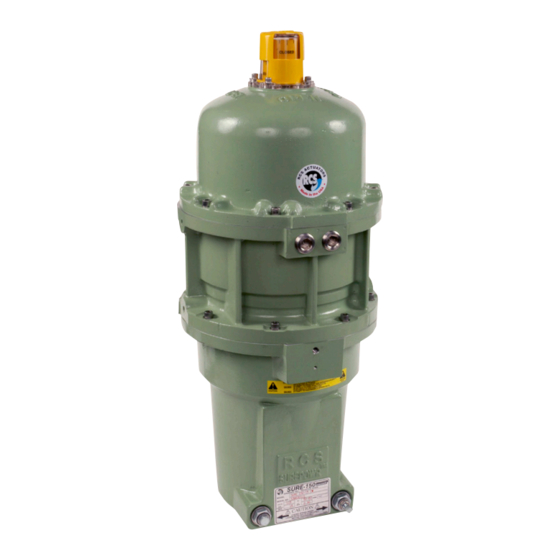Dresser Surepowr Sure 150 Manuale di installazione - Pagina 12
Sfoglia online o scarica il pdf Manuale di installazione per Controllore Dresser Surepowr Sure 150. Dresser Surepowr Sure 150 16. Rcs actuators

To set the counter-clockwise
(spring fail position) switch:
a.
Ensure the actuator is positioned in the counter-
clockwise (fail) position. Ensure the end of travel
stop is properly adjusted (see Mechanical Stop
Setting section). Loosen the setscrews on Cam 2
(1/16-inch hex drive). Rotate Cam 2 clockwise away
from its switch until it clears the switch lever.
b.
Rotate Cam 2 counter-clockwise until it comes
in contact with its switch lever and the switch
"breaks" (a light "click" can be heard). Continue to
rotate the cam slightly in the counter-clockwise
direction; this ensures that the motor will be
switched off before the actuator reaches its end
of travel stop. Tighten the setscrews on Cam 2.
To set the clockwise switch:
With the actuator in its full clockwise position,
loosen set screws on Cam 1 so as to trip Switch 1
at this position.
Auxiliary Switches:
Set Cams 3 and 4 to trip auxiliary switches as required for
the application.
Replace the cover and cover the screws in
accordance with the specifications stated in the
Installation section of this manual.
Limit Switch Settings (Optional Offering)
Installation
SurePowr actuators can be supplied for clockwise or
counter-clockwise spring-driven rotation (viewed from the
top of the actuator). The spring drive rotation is noted on
the actuator name tag and wiring diagram. Ensure that
the actuator has been supplied with the proper spring drive
operation for the application prior to installation on the
a.
The actuator is shipped in the power off (fail)
position. Ensure that the driven device is oriented to
its fail position prior to installation of the actuator.
b.
Care should be taken to maintain proper alignment
between the actuator and the device shaft. If the
actuator is not in the correct alignment with the
device shaft, repeat the procedure in Step 1.
c.
Mount the actuator to the device. Ensure the
actuator is centered properly with the device shaft,
and then tighten all bolts and nuts evenly.
d. Remove the cover bolts located around the
actuator motor and control cover flange.
e.
Terminate field wiring per the appropriate RCS wiring
diagram supplied with the actuator. Use a minimum
of #18 AWG stranded wire.
12
NOTE:
driven device.
Ensure the driven device is properly positioned
in its full fail position. If it is not, use the adjustable end
of travel stop on the Sure 100 (see Figure 4) to
properly adjust the fail end of travel stop.
Only the fail end of travel may be adjusted.
Loosen the lock nut to free the adjusting screw,
then use a wrench to turn the screw.
The total adjustment available is +/- 5°.
Figure 7
Switch adjustments for clockwise spring fail
operation (viewed from the top of the actuator)
a.
Ensure the actuator is de-energized and positioned
in the clockwise (fail) position. Ensure the end of
travel stop is properly adjusted. Rotate the screw
clockwise to move the actuator output shaft in a
counter-clockwise direction. Rotate the screw in a
counter-clockwise direction to move the actuator
output shaft in a clockwise direction. Loosen the
setscrews on Cams 1 and 3. Rotate both counter-
clockwise until they clear the switch arm rollers of
Switches 1 and 3.
b.
Rotate Cam 1 clockwise until it comes in contact with
Switch 1's arm roller and the switch "breaks".
A light "click" can be heard. Tighten the setscrews
on Cam 1.
c.
Rotate Cam 3 clockwise until it comes in contact with
Switch 3's arm roller and the switch just "breaks". A
light "click" can be heard.
d. Rotate Cam 3 slightly further in the clockwise
direction. This ensures that Switch 3 will "break"
just prior to the actuator reaching the full fail
position. Tighten the setscrews on Cam 3.
Energize the actuator. This will move the
actuator to the opposite end of travel.
CAUTION:
Equipment Operation
Closely monitor the electrical stroke, as the travel limit switches
are not yet properly adjusted. Ensure the actuator does not
over-travel and damage the driven equipment.
NOTE:
